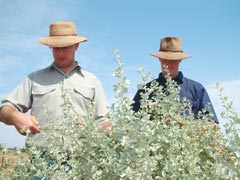
New way with old man saltbush

The NSW Department of Primary Industries (DPI) is investigating a novel way to integrate saltbush into mixed farming systems to help lift productivity and profitability across the NSW wheat-belt on the southern, central and northern slopes and plains.
A trial at the Condobolin Agricultural Research and Advisory Station has been funded by Grain & Graze to explore the benefits of alley farming with old man saltbush (OMSB).
NSW DPI research agronomist, Richard Maccallum, said rows or alleys of OMSB were planted over 20 per cent of the paddock with grain and pasture crops grown between the alleys.
“We’re measuring the costs and returns of crop production, animal performance, soil health, hydrology effects and improvements in biodiversity and comparing those results with paddocks that haven’t been planted with saltbush alleys,” Mr Maccallum said.
“Rather than just looking at the individual grain or grazing side of mixed-farming, we’re combining the two to help farmers lift productivity and profitability.”
Farmers can find out more about the trial and see how the Chase family use saltbush to boost beef production at an OMSB field day this Thursday, March 1 at “Waitara” north of Tottenham.
The NSW DPI trial consists of 15 sets of paired paddocks which will have a five-year cyclic rotation of cropping for two years and pasture phase of medics and lucerne for three years.
Mr Maccallum said OMSB can fill the feed-gap in summer and autumn when pasture is not on hand by providing high protein, green feed for sheep and cattle but their nutritional needs must be managed.
“It’s not a stand-alone feed so stock need additional dry grass in the paddock or grain to maximise production,” he said.
OMSB is drought tolerant with deep roots taking advantage of groundwater and reducing salinity. It also allows regeneration of native grass in the alleys and boosts biodiversity.
Information about saltbush establishment and management will be available and Yanco-based NSW DPI livestock officer, Geoff Duddy, will discuss animal nutrition at the Graze & Graze OMSB Field Day.
Grain & Graze, a collaborative partnership between Land & Water Australia, the Grains Research and Development Corporation, Meat & Livestock Australia, and Australian Wool Innovation Limited, links research and on-farm trials with a high level of farmer input.
Email:

